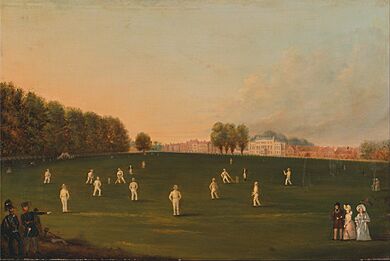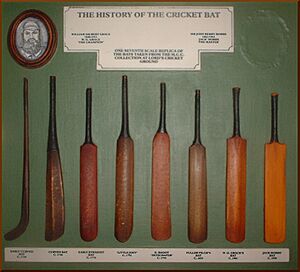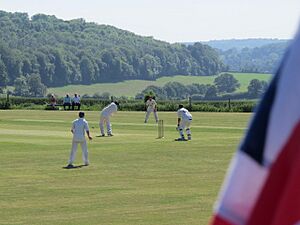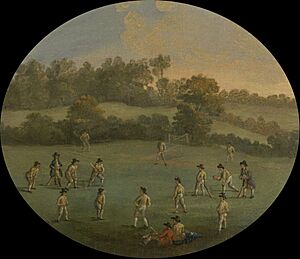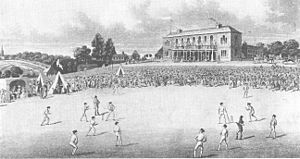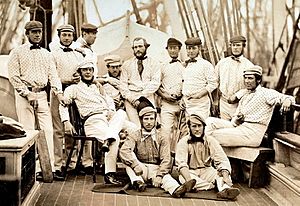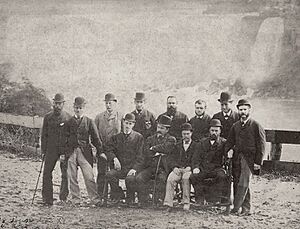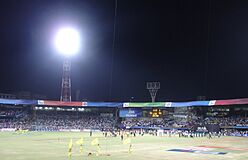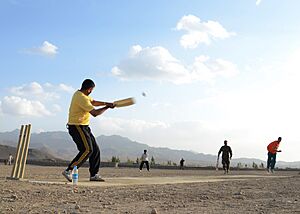History of cricket facts for kids
Cricket is a super fun sport with a long and interesting history! It started in England in the late 1500s. By the 1700s, it was a well-known game there. Then, in the 1800s and 1900s, cricket spread all over the world.
Teams from different countries have played against each other since the 1800s. The first official "Test cricket" matches happened in 1877. Today, cricket is the second most popular sport to watch globally, right after soccer!
The International Cricket Council (ICC) is like the main boss of cricket. It has over 100 member countries. However, only twelve of these countries currently play Test cricket, which is the longest form of the game.
The rules for cricket are called the "Laws of cricket". There are many ways to play! Some games, like T-10, are super fast and last about 90 minutes. Others, like Test matches, can go on for up to five days!
Contents
The Exciting History of Cricket
Where Did Cricket Begin?
Many people believe cricket started a long, long time ago in England. It might have been invented by children in a wooded area called the Weald during the time of the Saxons or Normans. The first clear written mention of cricket is from the late 1500s.
Some people thought cricket might have come from France or Flanders. There's an old record from the year 1300 that talks about King Edward II playing "creag and other games." Some wondered if "creag" meant cricket, but experts now think it just meant "fun and games."
Cricket was probably a children's game for many years. Then, around the 1600s, adults started playing it too. It might have grown out of a game like bowls. Imagine someone trying to hit the ball away to stop it from reaching a target!
Early cricket was played in fields where sheep grazed. The first equipment was very simple. A ball might have been a lump of sheep's wool, a stone, or a piece of wood. The bat could have been a stick or a farm tool. And the "wicket" (the target) might have been a stool, a tree stump, or a gate.
How Cricket Got Its Name
The word "cricket" itself has an interesting past! When it was first written down, it was spelled "creckett." The name might come from several old words:
- From Middle Dutch, "krick" meant a stick.
- From Old English, "cricc" or "cryce" meant a staff or crutch.
- From French, "criquet" meant a small wooden post.
There's also a Middle Dutch word, "krickstoel," which was a low stool. This stool looked a bit like the early cricket wickets! Some experts even think "cricket" came from a Dutch phrase for hockey, meaning "with the stick chase." It's likely that the name came from words used in England that were influenced by Dutch words due to trade.
Cricket in Early England
After a big conflict called the Civil War ended in 1648, the government made rules about what people could do for fun. They wanted people to be more serious, especially on Sundays. This might have made cricket less popular for a while, as Sundays were when many people had free time.
However, cricket continued to be played in some schools. It seems that important people, like the nobility, also started to enjoy cricket by joining in village games.
When things became more relaxed after 1660, cricket became very popular again! People started placing bets on games, and some historians think this is when the first really important matches began. In 1664, a law was even made to control how much money people could bet. By the late 1600s, cricket was a big sport for betting, with newspaper reports talking about a "great match" played for large sums of money.
Newspapers started reporting on cricket after 1696, when they gained more freedom. But at first, they mostly wrote about the bets, not so much about how the game was played.
Cricket Spreads Around the World
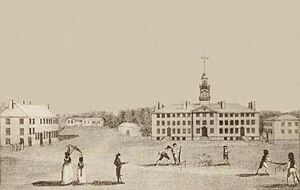
People who liked to bet on cricket sometimes formed their own teams. This led to the first "county teams" in England. Wealthy people, called patrons, started hiring skilled players from villages. The first known game between teams using county names was in 1709.
Important patrons like the Duke of Richmond helped cricket grow. Around 1725, newspapers started writing more about cricket, and even mentioned individual players for the first time.
Cricket traveled to North America with English settlers in the 1600s. In the 1700s, it reached other parts of the world. Colonists brought it to the West Indies. Sailors from the East India Company introduced it to India. It arrived in Australia when people first settled there in 1788. New Zealand and South Africa started playing in the early 1800s.
Cricket didn't become as popular in Canada. Even though some people tried to promote it, it had to compete with baseball. During World War I, Canadian soldiers in France played baseball instead of cricket.
Rules of the Game Develop
No one knows exactly when the basic rules of cricket were first made. Things like the bat, ball, wicket, and how players get "out" slowly developed over time. In 1728, two important patrons, the Duke of Richmond and Alan Brodick, wrote down some agreements for a game. This helped make sure everyone knew the rules, especially about how bets were paid.
In 1744, the official "Laws of Cricket" were written down for the first time. They were updated in 1774 to include new ideas like lbw (leg before wicket) and rules about bat width. These laws also said that two umpires would make all the decisions.
A group called the "Star and Garter Club" created these laws. Later, in 1787, they founded the Marylebone Cricket Club (MCC) at Lord's. The MCC quickly became the main group in charge of the Laws of Cricket and still updates them today.
Cricket Grows in England
Cricket kept spreading across England. In 1751, Yorkshire was mentioned as a place where cricket was played. The way players bowled also changed. At first, the ball was rolled along the ground, like in bowls. But after 1760, bowlers started pitching the ball through the air, trying different speeds and directions.
Keeping scorecards became common in 1772. Since then, we have a much clearer picture of how the sport grew.
Some of the first famous cricket clubs were London and Dartford in the early 1700s. London played its games at the Artillery Ground. Other clubs followed, like Slindon, which had the support of the Duke of Richmond and a star player named Richard Newland.
But the most famous early club was Hambledon in Hampshire. It became very important around 1756. The club was founded in the 1760s and was the center of cricket for about 30 years. It had great players like batsman John Small and fast bowler Thomas Brett.
When bowlers started pitching the ball through the air, players needed a new kind of bat. The old "hockey stick" bats were only good for hitting balls rolled on the ground. So, the straight bat was invented!
The first official "first-class" matches began in 1772. We still have scorecards from three matches played by the Hambledon Club that year. These games were between a Hampshire team and an England team. The first was played at Broadhalfpenny Down on June 24 and 25.
Cricket in the 1800s: A Global Game
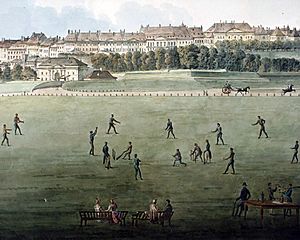
In the 1800s, cricket changed a lot. New "county clubs" were formed, like Sussex in 1839. Soon after, a player named William Clarke created a traveling team called the William Clarke's All-England Eleven in 1846. This team helped make cricket popular in many new places.
The growth of railways in the mid-1800s also helped cricket. Teams could travel further to play, and more fans could come to watch. British soldiers around the world also encouraged local people to play, creating fun competitions. Most parts of the British Empire embraced cricket, except for Canada.
In 1864, another big change happened in bowling: overarm bowling became legal. That same year, the famous Wisden Cricketers' Almanack was first published. A legendary player named W. G. Grace started his career around this time. He made many changes to how batting was done and helped cricket become even more popular.
First International Matches
The very first international cricket game was played in 1844 between the US and Canada. It took place in New York.
In 1859, a team of English professional players went on the first overseas tour to North America. Then, in 1862, an English team toured Australia. A special moment happened between May and October 1868, when a team of Aboriginal Australians toured England. This was the first Australian cricket team to travel overseas.
In 1877, an English team played two matches against Australian teams in Australia. These games are now known as the first official Test matches. The next year, the Australians toured England, and their success made people want more international games. This led to the famous "The Ashes" series in 1882, after Australia won a close match at The Oval.
South Africa became the third country to play Test cricket in 1889.
Why Cricket Didn't Catch On Everywhere
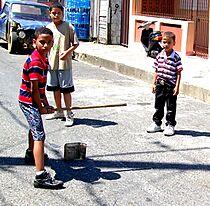
Cricket was once quite popular in the United States. Simpler versions of the game, like wicket, made it even more fun. However, baseball became more popular during the American Civil War. Soldiers played baseball because it was quicker and could be played almost anywhere. When they went home, they took baseball with them.
Baseball also became more popular in Japan due to American influence. In Latin America, cricket arrived in the 1800s but was mostly played by British people living there and a few wealthy locals. By the 1900s, baseball became the main bat-and-ball sport in the Caribbean. Many British people returned home during World War I, which reduced cricket's support in places like Mexico.
Cricket's Popularity in Colonies
Cricket grew in popularity in many places that were part of the British Empire. British leaders often worked with local important people. These local leaders were encouraged to adopt British traditions, including cricket. Playing cricket was seen as a way to connect with British culture.
For people living in the colonies, cricket became popular for different reasons. Some local leaders played it to become more like the British. Others, who wanted their countries to be independent, used cricket as a way to show their strength and challenge stereotypes.
Big Competitions Begin
A big change in cricket happened in 1890 when the official County Championship started in England. Soon after, in 1894, the rules for "first-class" cricket were officially set. Other countries followed this idea. Australia started the Sheffield Shield in 1892–93. South Africa created the Currie Cup, New Zealand had the Plunket Shield, and India started the Ranji Trophy.
The time from 1890 until World War I is often called the "Golden Age of cricket". People remember it fondly because teams played with a great spirit. Many famous players like Grace, Wilfred Rhodes, and Victor Trumper played during this era.
How Overs Changed
For most of the 1800s, a standard "over" in cricket had four balls. In 1889, five-ball overs were introduced in first-class cricket. Then, in 1900, six-ball overs became the usual length.
In the 1900s, some countries, like Australia, South Africa, and New Zealand, sometimes used eight-ball overs. But since the 1979-1980 seasons in Australia and New Zealand, six balls per over have been used everywhere in the world. The most recent rules only allow six-ball overs.
Modern Cricket: 1900s and Beyond
Cricket Goes International
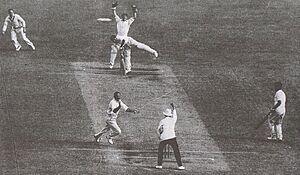
Cricket continued to spread to many countries. The Imperial Cricket Conference (ICC) was created in 1909. England, Australia, and South Africa were the first members. The ICC's goal was to manage international cricket between these three nations.
In 1926, New Zealand and the West Indies joined, allowing them to play Test cricket. However, at this time, cricket in the West Indies was mostly played by the white population. The ICC was not very interested in making cricket popular in many new countries. They were slow to invite non-Commonwealth nations to join.
India also became a Test-playing nation before World War II, and Pakistan joined in 1952.
In 1965, the ICC expanded to include countries that didn't play Test cricket, called "Associate members." The organization also changed its name to the International Cricket Conference. The first limited-overs World Cups were played in the 1970s. Sri Lanka became the first Associate member to gain Test status in 1982.
The international game kept growing. In 1984, "Affiliate Member" status was created for countries with less cricket history. In 1989, the ICC renamed itself the International Cricket Council. Zimbabwe became a full member in 1992, and Bangladesh in 2000. Most recently, Afghanistan and Ireland joined as Test teams in 2018, bringing the total number of full ICC members to 12.
A Time of Change in South Africa
A big challenge for international cricket came from a policy in South Africa called apartheid. This policy treated people unfairly because of their race. In 1961, South Africa left the Commonwealth of Nations, which meant its cricket board had to leave the ICC.
Cricket's opposition to apartheid grew stronger in 1968. South African officials canceled England's tour because the English team included Basil D'Oliveira, a player of mixed race. In 1970, the ICC members voted to stop South Africa from playing international cricket for a long time.
Because South Africa's best players couldn't play in official international games, the South African Cricket Board started paying players from other countries to come and play in "rebel tours." The ICC said that any players who went on these rebel tours would not be allowed to play in official international cricket. Many players, especially those nearing the end of their careers, accepted the offer because they didn't earn much money in the 1970s.
These rebel tours continued into the 1980s. But then, big changes happened in South African politics, and apartheid ended. South Africa, now a "Rainbow Nation" under Nelson Mandela, was welcomed back to international sports in 1991.
New Ways to Play Cricket
Players not earning much money also led to another cricket challenge in 1977. An Australian media boss named Kerry Packer had a disagreement with the Australian Cricket Board about TV rights. He offered many of the world's best players large sums of money to play in his own private cricket league, outside of official international cricket. This "World Series Cricket" even included some of the banned South African players.
This disagreement lasted until 1979. The players who had joined Packer's league were allowed back into official international cricket. World Series Cricket led to much higher salaries for players and new ideas like colorful uniforms and night games.
Limited-Overs Cricket
In the 1960s, English county teams started playing a new, shorter version of cricket. These games had only one innings per team and a limited number of overs. This "limited-overs cricket" became very popular. In 1969, a national league for this format was created.
Many traditional cricket fans didn't like the shorter games at first. However, limited-overs cricket had a big advantage: a game could finish in just one day! This made cricket more appealing to younger people or those with less time. It also became very successful commercially.

The first international limited-overs match happened in 1971 in Australia. It was played as an experiment after a Test match was stopped by rain. It turned out to be incredibly popular! Since then, "One Day Internationals" (ODIs) have become a huge part of the game.
The International Cricket Council responded to this popularity by organizing the first Cricket World Cup in England in 1975. All the Test-playing nations took part.
Technology Helps Cricket Fans
Limited-overs cricket made watching games on TV much more popular. New ways of showing the game on TV, first used for limited-overs matches, soon came to Test cricket too. These included:
- Showing detailed statistics and graphics.
- Placing tiny cameras inside the stumps.
- Using many cameras to show the game from different angles.
- Using super-fast cameras and computer graphics to help viewers understand how a ball was bowled and why an umpire made a decision.
In 1992, a "third umpire" was introduced to help with "run-out" decisions using TV replays. The third umpire's job has grown to include decisions on other parts of the game, like stumpings and catches. Since 2011, the third umpire has also helped review umpires' decisions using special tracking technology like Hawk-Eye and Hot Spot.
Cricket Today: Even More Exciting!
In June 2001, the ICC created a "Test Championship Table" to rank Test teams. In October 2002, they added a "One-day International Championship Table." Cricket continues to be a major sport in many former British Empire countries, especially in India and its neighbors. New countries like the Netherlands have also joined in.
In 2017, Afghanistan and Ireland became full ICC members, bringing the total to twelve. The ICC is working to help more countries develop their cricket teams. They are focusing on nations in Africa, Asia, and the United States. In 2004, the ICC Intercontinental Cup allowed 12 nations to play first-class cricket, many for the first time.
T20 Cricket and Shorter Formats' Growth
Cricket's newest and most exciting idea is Twenty20 (T20). This format started in 2003 and is usually played in the evening. It has become incredibly popular, attracting huge crowds and great TV ratings. The first ICC Twenty20 World Cup was held in 2007.
The creation of T20 leagues, like the Indian Premier League (starting in 2008), has made many people wonder about the future of cricket.
Even shorter versions of cricket have appeared. The T10 format is played in about 90 minutes. There's also the 100-ball format, played in "The Hundred" competition in England. In this game, bowlers bowl 5 balls in an over and can bowl two overs in a row.


